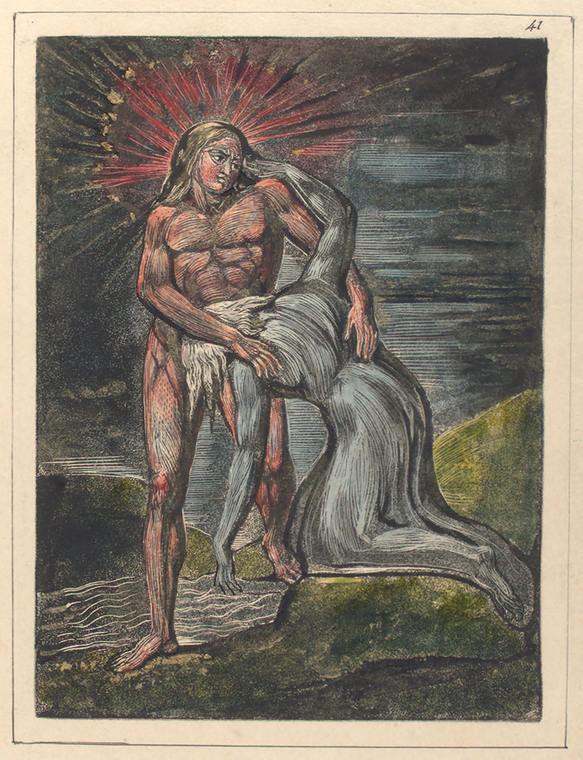Genesis 2
[6] But there went up a mist from the earth, and watered the whole face of the ground.
[7] And the LORD God formed man of the dust of the ground, and breathed into his nostrils the breath of life; and man became a living soul.
[8] And the LORD God planted a garden eastward in Eden; and there he put the man whom he had formed.
[9] And out of the ground made the LORD God to grow every tree that is pleasant to the sight, and good for food; the tree of life also in the midst of the garden, and the tree of knowledge of good and evil.
In A Blake Dictionary, S. Foster Damon tells us on Page 88: "Clay is the living substance with which the creator works." He supports his statement with passages from Milton and Jerusalem:
Milton, Plate 28 [30], (E 126)
"Antamon takes them into his beautiful flexible hands,
As the Sower takes the seed, or as the Artist his clay"
 |
| New York Public Library Milton Plate 41 |
Jerusalem, Plate 27, (E 173) "He witherd up the Human Form, By laws of sacrifice for sin: Till it became a Mortal Worm: But O! translucent all within. The Divine Vision still was seen Still was the Human Form, Divine Weeping in weak & mortal clay O Jesus still the Form was thine. And thine the Human Face & thine The Human Hands & Feet & Breath Entering thro' the Gates of Birth And passing thro' the Gates of Death"
In this passage in Milton we find the hard, unyielding, selfish pebble of our original poem as Urizen in the confrontation with Milton. Urizen attempts to subdue Milton with icy water poured on his brain. Milton replies by molding a human form of flesh for Urizen from the red clay of Succoth.
Milton, Plate 19 [21], (E 112)
"Urizen emerged from his Rocky Form & from his Snows,
PLATE 19 [21]
And he also darkend his brows: freezing dark rocks between
The footsteps. and infixing deep the feet in marble beds:
That Milton labourd with his journey, & his feet bled sore
Upon the clay now chang'd to marble; also Urizen rose,
And met him on the shores of Arnon; & by the streams of the brooks
Silent they met, and silent strove among the streams, of Arnon
Even to Mahanaim, when with cold hand Urizen stoop'd down
And took up water from the river Jordan: pouring on
To Miltons brain the icy fluid from his broad cold palm.
But Milton took of the red clay of Succoth, moulding it with care
Between his palms: and filling up the furrows of many years
Beginning at the feet of Urizen, and on the bones
Creating new flesh on the Demon cold, and building him,
As with new clay a Human form in the Valley of Beth Peor."
Genesis 1[26] And God said, Let us make man in our image, after our likeness: and let them have dominion over the fish of the sea, and over the fowl of the air, and over the cattle, and over all the earth, and over every creeping thing that creepeth upon the earth.
[27] So God created man in his own image, in the image of God created he him; male and female created he them.
lovely! thanks so much, Ellie. I'm not sure I'm understanding the Milton passage though. I did find these KJV Bible passages that refer to clay and Succoth: 1 Kings 7:45-46, and 2 Chronicles 4:16-17.
ReplyDeleteSusan
valley of Beth Peor:
ReplyDeleteDeut 3:29, 4:46, 34:6 (and maybe Joshua 13:20)
those are some of the dots, but I'm not having much success connecting them....
Thanks Susan, you pushed me to make more connections of the dots.
ReplyDeleteI believe the use of the word Succoth is to push us in the direction of the Exodus. Jesus reenacted the Exodus by leading his people out of the bondage to sin and death and into the promised land of living in the spirit.
The words Beth Peor direct us to the burial of Moses outside of the promised land.
This post on the Burial of Moses explains some of the symbolism from the OT that Blake was working with in his book Milton.
http://ramhornd.blogspot.com/2011/12/burial-of-moses.html